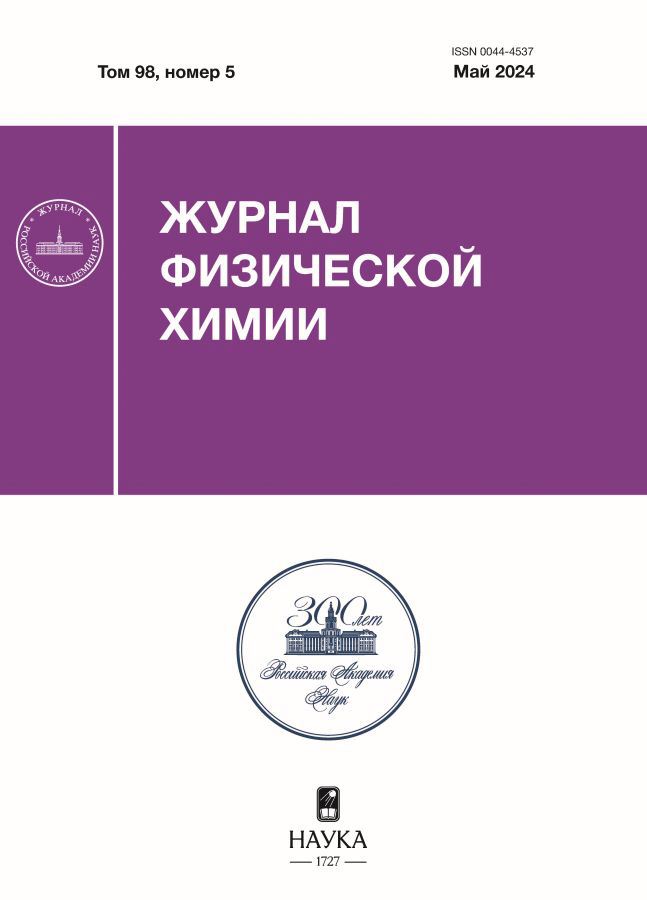Исследование спектра ионизации 6,6-диметил-фульвена методами алгебраического диаграммного построения и связанных кластеров
- 作者: Трофимов А.Б.1,2, Скитневская А.Д.1, Белоголова А.М.1,2, Якимова Э.К.1, Громов Е.В.1
-
隶属关系:
- ФГБОУ ВО Иркутский государственный университет
- ФГБУН Иркутский институт химии им. А. Е. Фаворского СО РАН
- 期: 卷 98, 编号 5 (2024)
- 页面: 70-77
- 栏目: ВЫЧИСЛИТЕЛЬНАЯ И КВАНТОВАЯ ХИМИЯ
- ##submission.dateSubmitted##: 27.02.2025
- ##submission.datePublished##: 29.12.2024
- URL: https://freezetech.ru/0044-4537/article/view/668985
- DOI: https://doi.org/10.31857/S0044453724050094
- EDN: https://elibrary.ru/PJWUHG
- ID: 668985
如何引用文章
详细
Электронная структура и спектр ионизации 6,6-диметил-фульвена рассчитаны с использованием метода алгебраического диаграммного построения третьего порядка для одночастичной функции Грина (IP-ADC(3)) и метода уравнений движения для связанных кластеров в приближении модели однократных и двукратных возбуждений (IP-EOM-CCSD). Результаты использованы для интерпретации недавно полученного фотоэлектронного спектра 6,6-диметил-фульвена [M. H. Palmer et. al, Chem. Phys. Lett. 2022, 796, 139558]. Предложен ряд новых отнесений, среди которых наиболее значимым является отнесение ранее неотнесенного плеча третьей фотоэлектронной полосы в районе 10.5 эВ, которое согласно нашим IP-ADC(3)-расчетам, образовано сателлитными переходами, связанными с p-орбиталями фульвенового кольца 2a2 и 2b1. Полученные в работе данные также позволяют полагать, что у метода IP-EOM-CCSD и эквивалентных ему подходов имеются трудности с корректным описанием сателлитных состояний.
全文:
作者简介
А. Трофимов
ФГБОУ ВО Иркутский государственный университет; ФГБУН Иркутский институт химии им. А. Е. Фаворского СО РАН
编辑信件的主要联系方式.
Email: abtrof@mail.ru
俄罗斯联邦, 664003 Иркутск; 664033 Иркутск
А. Скитневская
ФГБОУ ВО Иркутский государственный университет
Email: abtrof@mail.ru
俄罗斯联邦, 664003 Иркутск
А. Белоголова
ФГБОУ ВО Иркутский государственный университет; ФГБУН Иркутский институт химии им. А. Е. Фаворского СО РАН
Email: abtrof@mail.ru
俄罗斯联邦, 664003 Иркутск; 664033 Иркутск
Э. Якимова
ФГБОУ ВО Иркутский государственный университет
Email: abtrof@mail.ru
俄罗斯联邦, 664003 Иркутск
Е. Громов
ФГБОУ ВО Иркутский государственный университет
Email: abtrof@mail.ru
俄罗斯联邦, 664003 Иркутск
参考
- Preethalayam P., Krishnan K.S., Thulasi S. и др. // Chem. Rev. 2017. Т. 117. № 5. С. 3930. https://doi.org/10.1021/acs.chemrev.6b00210
- Swan E., Platts K., Blencowe A. // Beilstein J. Org. Chem. 2019. Т. 15. С. 2113. https://doi.org/10.3762/bjoc.15.209
- Martin-Somer A., Xue X.-S., Jamieson C.S. и др. // J. Am. Chem. Soc. 2023. Т. 145. № 7. С. 4221. https://doi.org/10.1021/jacs.2c12871
- Lindner M.M., Alachraf M.W., Mitschke B. и др. // Angew. Chemie Int. Ed. 2023. Т. 62. № 35. C. e202303119. https://doi.org/10.1002/anie.202303119
- Scott A.P., Agranat I., Biedermann P.U. и др. // J. Org. Chem. 1997. Т. 62. № 7. С. 2026. https://doi.org/10.1021/jo962407l
- Replogle E.S., Trucks G.W., Staley S.W. // J. Phys. Chem. 1991. Т. 95. № 18. С. 6908. https://doi.org/10.1021/j100171a031
- Gleiter R., Heilbronner E., Meijere A. de. // Helv. Chim. Acta. 1971. Т. 54. № 4. С. 1029. https://doi.org/10.1002/hlca.19710540409
- Palmer M.H., Coreno M., De Simone M. и др. // Chem. Phys. Lett. 2022. Т. 796. С. 139558. https://doi.org/10.1016/j.cplett.2022.139558
- Cederbaum L.S., Domcke W., Schirmer J., Von Niessen W. Adv. Chem. Phys. / Eds. I. Prigogine, S.A. Rice., Wiley Online Library. 1986. Т. LXV. С. 115. https://doi.org/10.1002/9780470142899.ch3
- Nakatsuji H., Hirao K. // J. Chem. Phys. 1978. Т. 68. № 5. С. 2053. https://doi.org/10.1063/1.436028
- Nakatsuji H. // Chem. Phys. Lett. 1979. Т. 67. № 2–3. С. 334. https://doi.org/10.1016/0009-2614(79)85173-8
- Ehara M., Hasegawa J., Nakatsuji H. // Theory and Applications of Computational Chemistry.: Elsevier, 2005. С. 1099. https://doi.org/10.1016/B978-044451719-7/50082-2
- Schirmer J., Cederbaum L.S., Walter O. // Phys. Rev. A. 1983. Т. 28. № 3. С. 1237. https://doi.org/10.1103/PhysRevA.28.1237
- Schirmer J., Trofimov A.B., Stelter G. // J. Chem. Phys. 1998. Т. 109. № 12. С. 4734. https://doi.org/10.1063/1.477085
- Dempwolff A.L., Paul A.C., Belogolova A.M. и др. // Ibid. 2020. Т. 152. № 2. С. 024113. https://doi.org/10.1063/1.5137792
- Patanen M., Abid A.R., Pratt S.T. и др. // Ibid. 2021. Т. 155. № 5. С. 054304. https://doi.org/10.1063/5.0058983
- Trofimov A.B., Holland D.M.P., Powis I. и др. // Ibid. 2017. Т. 146. № 24. С. 244307. https://doi.org/10.1063/1.4986405
- Nooijen M., Bartlett R.J. // Ibid. 1995. Т. 102. № 9. С. 3629. https://doi.org/10.1063/1.468592
- Sinha D., Mukhopadhya D., Chaudhuri R. и др. // Chem. Phys. Lett. 1989. Т. 154. № 6. С. 544. https://doi.org/10.1016/0009-2614(89)87149-0
- Stanton J.F., Gauss J. // J. Chem. Phys. 1994. Т. 101. № 10. С. 8938. https://doi.org/10.1063/1.468022
- Dunning T.H. // Ibid. 1989. Т. 90. № 2. С. 1007. https://doi.org/10.1063/1.456153
- Kendall R.A., Dunning T.H., Harrison R.J. // Ibid. 1992. Т. 96. № 9. С. 6796. https://doi.org/10.1063/1.462569
- Shao Y., Gan Z., Epifanovsky E. et al. // Mol. Phys. 2015. Т. 113. № 2. С. 184. https://doi.org/10.1080/00268976.2014.952696
- Frisch M.J., Trucks G.W., Schlegel H.B., Scuseria G.E., Robb M.A., Cheeseman J.R., Scalmani G., Barone V., Petersson G.A., Nakatsuji H., X. Li, Caricato M., Marenich A.V., Bloino J., Janesko B.G., Gomperts R., Mennucci B., Hratchian H.P., Ortiz J.V., Izmaylov A.F., Sonnenberg J.L., Williams-Young D., Ding F., Lipparini F., Egidi F., Goings J., Peng B., Petrone A., Henderson T., Ranasinghe D., Zakrzewski V.G., Gao J., Rega N., Zheng G., Liang W., Hada M., Ehara M., Toyota K., Fukuda R., Hasegawa J., Ishida M., Nakajima T., Honda Y., Kitao O., Nakai H., Vreven T., Throssell K., J. Montgomery J.A., Peralta J.E., Ogliaro F., Bearpark M., Heyd J.J., Brothers E., Kudin K.N., Staroverov V.N., Keith T.A., Kobayashi R., Normand J., Raghavachari K., Rendell A., Burant J.C., Iyengar S.S., Tomasi J., Cossi M., Millam J.M., Klene M., Adamo C., Cammi R., Ochterski J.W., Martin R.L., Morokuma K., Farkas O., Foresman J.B., Fox D.J. Gaussian 16 Revision A.03, Gaussian, Inc., Wallingford, CT, 2016
- Schaftenaar G., Vlieg E., Vriend G. // J. Comput. Aided. Mol. Des. 2017. Т. 31. № 9. С. 789. https://doi.org/10.1007/s10822-017-0042-5
- Swiderek P., Michaud M., Sanche L. // J. Chem. Phys. 1995. Т. 103. № 19. С. 8424. https://doi.org/10.1063/1.470153
- Asmis K.R., Allan M., Schafer O. et al. // J. Phys. Chem. A. 1997. Т. 101. № 11. С. 2089. https://doi.org/10.1021/jp963129x
- Trofimov A., Schirmer J., Holland D.M. P. et al. // Chem. Phys. 2001. Т. 263. № 1. С. 167. https://doi.org/10.1016/S0301-0104(00)00334-7
补充文件


























